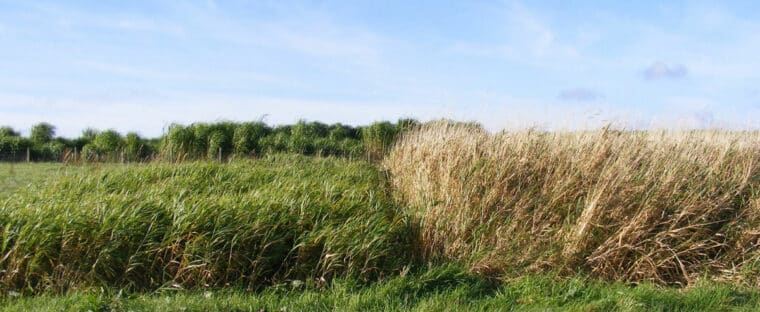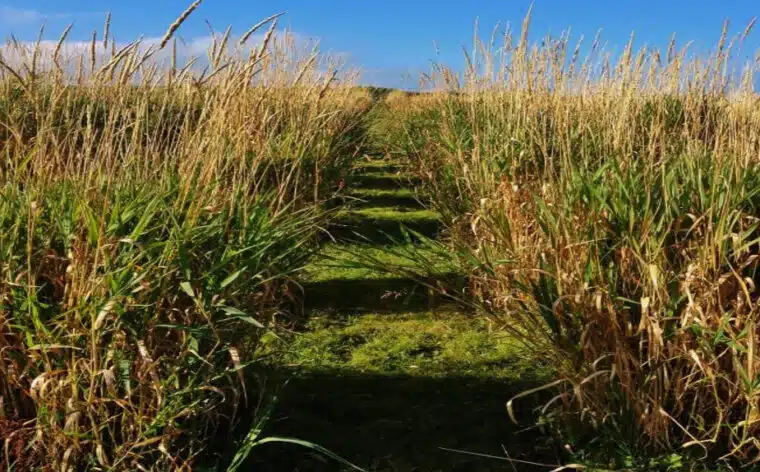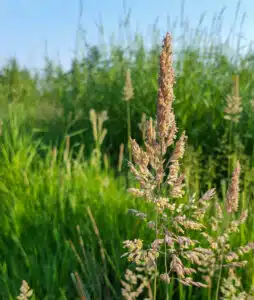Reed Canary Grass as a Biomass Crop
Key messages:
- Reed canary grass is a perennial, lignocellulosic crop that is native to the UK and has multiple uses.
- It is established from seed, making set-up costs lower than for many other perennial biomass crops.
- Reed canary grass is a shorter-term crop (5-10 years) than Miscanthus and willow, with average yields of 5-7 tonnes of dry matter per ha, depending on management.
- It is tolerant of a range of land types and conditions including flooding, drought, and freezing.
- Reed canary grass can be grazed in early summer (depending on the variety) and harvested for diverse other uses from late summer until early spring. This extends the annual window of biomass availability and supports multiple end uses (e.g. anaerobic digestion, combustion, animal bedding, seed supply, game cover).
Introduction
Reed canary grass (Phalaris arundinacea L.) is a multipurpose, lignocellulosic perennial crop native to Europe, Asia, and North America. It can be grown on poorly productive land and tolerates a wide range of conditions. Reed canary grass is found in diverse habitats including wetlands and riparian zones but also drier areas like roadsides, forest margins, pastures, and disturbed areas. It is a fast-growing crop reaching heights of 1.5-2 m in a growing season, and, depending on management, can remain productive for 5-10 years.
Uses and Benefits
 Reed canary grass can be utilised in diverse energy conversion processes like combustion, gasification, pyrolysis, and anaerobic digestion.
Reed canary grass can be utilised in diverse energy conversion processes like combustion, gasification, pyrolysis, and anaerobic digestion.- Reed canary grasshas a high gross calorific value (dry ~18.2 MJ kg-1), exceeding that of wheat and Miscanthus. Ash content (~3-8 %) depends particularly on harvest, management, and site.
- Reed canary grass has carbon sequestration potential and can be used for a prolonged ‘fallow’ period in a rotation where soil health can recover from more intensive arable practices and organic matter can be accrued.
- Reed canary grass creates habitat for diverse wildlife including birds and small mammals.
- Reed canary grass can mitigate greenhouse gas emissions and reduce nitrate leaching, acting as a buffer crop.
- Reed canary grass can be integrated into multifunctional landscapes as a biomass crop providing benefits of supporting ecosystem services and mitigating environmental impacts.
- Reed canary grass can be used for livestock feeding provided it is low in alkaloids (eg. Marathon or Palaton variety). It has good absorption properties and is a viable alternative to straw as bedding material for livestock.
- Reed canary grass has potential to remove contaminants from soil and water.
Establishment
Reed canary grass is planted by seed. It requires a firm, smooth seedbed and timely weed control during establishment, with fertiliser where nitrogen is limiting. Seed can be broadcasted or planted using a conventional seed drill. Conventional seed drilling provides more uniform stand development and seed depth. The ideal time to plant Reed canary grass is between March and April when soils are moist, and the root system has plenty of time to establish. The recommended seeding rate for forage production is 5-10 kg ha-1 with row spacing of 12.5 cm, at a depth of about 2 cm. Rolling is recommended both before and after sowing to conserve the moisture in the seedbed followed by application of broadleaf herbicide to control weeds. Growth can be slow during the first year of cultivation while the root and rhizome system establishes. Harvesting can usually commence from year two. Nutrients translocate to the rhizomes over the autumn and winter period, providing energy for new shoots in spring, and improving the sustainability of the crop and quality of the biomass for combustion purposes.
Site Suitability
Reed canary grass is highly tolerant to waterlogging (established stands can tolerate extended periods of inundation) and a wide pH range from pH 4.9 to pH 8.2. It can thrive on marginal land unsuitable for food or feed production. Once established, Reed canary grass is one of the most productive temperate grasses during drought due to its deep rhizome and root system. As a temperate grass used extensively in Scandinavia, it is also highly tolerant of freezing conditions.
Biomass production and harvesting
Average yields of 5-7 tonnes per hectare are achievable in the UK, depending on management, although ‘pushing’ the crop may decrease crop overall persistence. Yields will be improved by fertilisation where nutrients are limiting although over fertilising may promote lodging. Harvesting the crop green will reduce sustainability, as nutrients not yet translocated to the below-ground biomass will be removed.

Reed canary grass under two harvesting regimes (autumn, LHS; spring RHS) on shallow, stony soil in West Wales.
Harvesting can be conducted with conventional grass harvesting machinery and usually commences from the second year after sowing.
The timing of harvest depends on the intended market/end-use. Forage quality is best in spring and early summer, while harvest for anaerobic digestion can extend from summer until autumn senescence begins. For combustion and animal bedding, harvesting is best delayed until late winter or early spring, where combustion quality will be improved through nutrient translocation below ground, leading to lower contents of sodium, potassium, chlorine and moisture (ca. 10-15%). Spring-harvested biomass requires little or no drying. The crop is typically mown first before being baled and transported.
Alternatively, the grass can be cut and chipped using a forage harvester. Eliminating the crop after productive years will be easiest using herbicides e.g., glyphosate, although repeated cutting and conventional tillage may suffice.Although harvesting reed canary grass green will remove nutrients, increasing the need for fertiliser, research has shown costs can be reduced using sewage sludge or nitrogen-fixing legumes.
Pests and Diseases
Reed canary grass disease levels are relatively low and are not considered a cause for concern (they include brown rust, mildew, buff spot, powdery mildew, and Rhynchosporium (leaf scald)). However, reed canary grass can be attacked by insect larvae, which feed inside stem bases and can occasionally significantly reduce yield. Damage from rabbits and slugs can occur during the first year of establishment.
Economics
Returns during the first year are low, as establishment costs will not be balanced by revenue from biomass production. A study conducted in the UK found an average gross margin of £153.89 ha-1 for reed canary grass grown in multiple sites. The gross margins ranged from a minimum of £110.60 ha-1 to a maximum of £219.40 ha-1 across the sites studied. The differences in the gross margin were attributed to the variations in yield among different sites and prices of the biomass.







